Eastern Wine and Eastern Grape Juice
New York, after its somewhat slow start, began to overhaul and soon passed all the other states outside California. In 1870, for example, New York stood sixth in wine production among the states, behind not only California and Ohio but Illinois and Pennsylvania too. By 1880 New York had closed to third, after California and Ohio; by 1890 New York stood second, and that was where it stayed until Prohibition put an end to the race.[1]
The regions of the state that stood out as winegrowing centers before the war remained in that position afterwards: the Hudson shores, the Finger Lakes, and the Lake Erie grape belt. Of the Hudson region there is little to add once it had been established: it maintained a fairly steady acreage of grapes but did not expand. Its nearness to the produce market of New York City made the Hudson region particularly attractive for growing table grapes, and its river climate made it attractive to fruit growing generally. Thus, instead of specializing in wine, the Hudson growers made grape growing a part of a general fruit-growing economy. The most encouraging development in the state was the spread of winegrowing in the Finger Lakes. Keuka Lake had been the original focus; there, by the end of the Civil War,
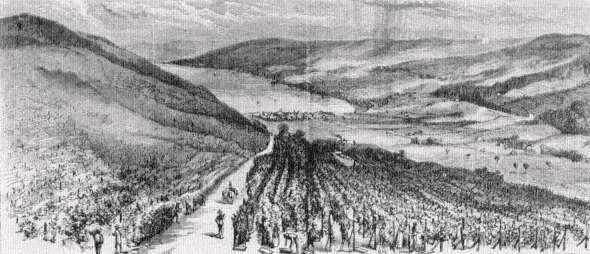
106
The vineyards of Pleasant Valley, above Hammondsport, New York, at the south end of Keuka Lake,
1872. The view is of the region shown on the map reproduced as figure 58 ( Harper's Weekly , 11 May 1872)
there were some 3,000 acres of vines divided among two hundred proprietors and served by three wineries.[2] By 1890, the year in which New York took over the second spot in the country, the Finger Lakes region had nearly 24,000 acres of vines, mostly still centered on Keuka Lake but with other large acreages around Seneca Lake to the east and Canandaigua Lake to the north and west. The vast bulk of the yield from New York's vineyards did not go the wineries but to the cities, in boxes and baskets, as grapes for the table.[3] The Keuka region, however, specialized in winemaking, as did the developing Naples Valley at the south end of Canandaigua Lake. After its beginning in 1861 with the Maxfield Winery, the wine trade in the Naples Valley picked up speed in the 1870s and expanded very rapidly in the 1880s. The leaders were largely Germans, as the pioneer Hiram Maxfield was: he was followed by such names as Miller, Dinzler, Kaltenbach, and Widmer (though the latter was, to be exact, Swiss).[4]
Finger Lakes wine was mostly white and came from the same varieties that had been established at the beginning, mainly Catawba and Delaware, with significant plantings of Elvira, Isabella, Moore's Early, and other varieties.[5] Sparkling wine continued to be a staple product, so that Finger Lakes "champagne" was almost synonymous with American sparkling wine down to Prohibition. At the turn of the century, for example, New York produced more than twice as much sparkling wine as all other domestic sources—California, Ohio, and Missouri—combined.[6] Some of that New York sparkling wine, however, was based on neutral California white wine imported in bulk to modify the flavors and the acidity of the wine from native varieties—a practice long established and still followed. The pioneer firms of the
Finger Lakes continued to be the major producers: Pleasant Valley ("Great Western," 1860) and the Urbana Wine Company ("Gold Seal," 1865). On Seneca Lake the first considerable commercial establishment was the Seneca Lake Wine Company, which put up its stone-built winery in 1870.[7] The Germania Wine Cellars were founded in that year in Hammondsport, and the next quarter of a century saw such further additions to the Finger Lakes list as the Hammondsport Wine Company, the Columbia Wine Cellars, the Lake Keuka Wine Company, the Empire State Wine Company, and the White Top Winery.[8] Something of an anomaly, but an important presence nonetheless, was the Paul Garrett Winery at Penn Yan, where, after 1912, the Garrett enterprises had their headquarters. Garrett's story properly belongs to that of North Carolina and will be told later in this chapter. Driven by a steadily encroaching zone of prohibitionist drought, Garrett left North Carolina for Virginia, then Virginia for New York, where he weathered Prohibition and reemerged as the genius behind the formation of Fruit Industries Incorporated, a combine of California and eastern interests that was the largest winemaking enterprise in the country. For a time, then, in virtue of Garrett's Penn Yan headquarters, the Finger Lakes region was the capital of the American wine trade. But that was an accident of the dislocations produced by Prohibition.
To the west, along the shores of Lake Erie in the New York and Pennsylvania grape belt, the production of wine from traditional varieties such as the Catawba continued, but only in a small way. As the century went on, the region was devoted more and more to the supply of grapes for the table; thus, by the end of the century, it was overwhelmingly dominated by the Concord grape. The first carload of grapes for the table market was shipped from the region in 1877, from Brocton to Philadelphia;[9] within a generation hundreds of carloads left the grape belt each fall for eastern and middle western cities. The success of this trade created a "grape fever" in the 1880s: "Lawyers, teachers, doctors, and even ministers of the gospel turned vineyardists," a local historian recalled at the turn of the century.[10] The concentration on table grapes rather than wine grapes was reinforced by the very strong local sentiment in favor of prohibition; Chautauqua County, the heart of the grape region, was also the home of the Chautauqua Institution, where the Woman's Christian Temperance Union was conceived,[11] and where the uplifting programs of "culture" purveyed at the institution were sustained on cold water and high thought alone. The shores of Lake Erie, ideally suited to viticulture, continued to be devoted to the grape, but increasingly less to wine. Not that winemaking was extinguished. The Brocton Wine Cellars, going back to the earliest days of wine production in the grape belt, continued to operate, and by 1900 had grown to a capacity of 250,000 gallons. Other wineries in the grape belt—the Lake Erie Cellars at Westfield, the Chautauqua Wine Company at Ripley, and the Portland Wine Cellars at Portland, to name a few—raised the region's total production to one and a half million gallons annually by the turn of the century.[12] A group of Italian winemakers concentrated in Fredonia also contributed to this total.[13]
Generally speaking, the development of table varieties received more attention
in New York than did the work on wine varieties. The excited interest in breeding new native grapes generated by the grape boom of the 1860s had greatly subsided but not entirely disappeared, and a steady stream of new introductions appeared in the latter half of the century. One of the most effectively ballyhooed of these was the Niagara, a green grape, which for a time was the light-colored counterpart in eastern vineyards of the dark-colored Concord. Niagara may be, and is still, used for wine, but its chief market was for the table, as were such other new introductions, now largely fallen out of use, as Champion, Croton, Empire State, Jefferson, and many others in a long list of local and patriotic names.[14]
One extremely promising experiment in New York never got a chance to develop: this was the work with vinifera vines carried out by the state's agricultural experiment station at Geneva, in the Finger Lakes. A grape-breeding program was started at the station in 1890, based on the station's own varietal collection: this was largely made up of native varieties but included experimental plantings of vinifera. By 1911 the station undertook a deliberate program of growing vinifera, with the idea of developing hybrids; some 101 varieties were planted, and four years later the results were encouraging enough to allow U.P. Hedrick, the director, to report that it was certainly possible to make the vines grow under New York conditions.[15] Two years later, in 1917, one of Hedrick's fellow workers wrote in a station bulletin that they now had satisfactory means for protecting vinifera from all four of the major pests in New York: mildew, black rot, phylloxera, and winter injury.[16] On that confident note the work so well begun flickered out in the darkness of Prohibition. The episode is well worth reporting, now that extensive experiment with vinifera is again being made in New York and elsewhere in the East. In the publicity surrounding the current trials, the earlier contribution of Hedrick and his associates ought not to be forgotten.
In Ohio, the shift from the south, where Ohio winegrowing was first established, to the north of the state along the Lake Erie shore was quite complete within just a few years after the Civil War. Ohio enjoyed an unspectacular, but fairly steady, growth in winemaking throughout the latter half of the nineteenth century, but the Cincinnati vignoble was gone. Of the two regions where wine-growing was focused along the Erie shore, the one centered on Cleveland was first, by a little, to be developed. A Lake Shore Grape and Wine Growers' Association held a convention at Cleveland in 1866, and next year the members displayed their wines at the Paris Exhibition.[17] Like their neighbors to the east in Chautauqua County, New York, the growers in the Cleveland area felt prohibitionist pressure from a very early date. In 1869, when there were already three hundred members of the association, its fourth meeting, held at Temperance (!) Hall in Cleveland voted to change the name of the group to the Ohio Grape Growers Association, dropping any reference to wine; the meeting also voted to exclude wine from future exhibitions. There were loud protests at these moves, but not enough to prevent them. The dissidents seceded and formed their own group under the old name in 1869, while the temperance branch soon disappeared into the Ohio State Hor-
ticultural Society.[18] Thus winemaking continued around Cleveland. Most of the vineyards were planted to Catawba in the early days, but as happened throughout the eastern part of the Lake Erie grape belt, the Concord and other table varieties came more and more to dominate. Winemaking in northeastern Ohio never attained any very considerable proportions, but it managed to persist for a long time: among the wineries of greater Cleveland were the Dover Bay Grape and Wine Company, the Lake View Wine Farm, and the Louis Harris Winery.[19]
The other focus of Ohio winegrowing was at Sandusky and the islands that lie scattered north of Sandusky Bay, in western Lake Erie. Vineyards here began to be planted in a substantial way about the end of the 1840s, and developed rapidly in the 1850s, largely through the work of German immigrants, and, as has been noted earlier, by growers who migrated from the doomed Cincinnati vineyards to the promising region of Lake Erie. One of them, the Alsatian Michael Werk and his sons, had 400 acres of vines near Vermillion by the 1870s.[20] Another northern Ohio producer, H. T. Dewey, of Sandusky, was one of the first to open a New York agency for eastern wines. When Dewey sent a shipment of his wines to New York in 1865, he found that no merchant was interested in them, or in eastern American wines generally. He thereupon opened his own store and continued to sell his American wines there even after he shifted his winemaking from Ohio to New Jersey.[21] Before the century was out, the Sandusky region was the undisputed center of Ohio wine production, from such wineries as those of the Diamond Wine Company, Duroy & Haines, the Sweet Valley Wine Company, and M. Hommell, among other names now vanished.[22] Sandusky was also the scene of important cooperage works, specializing in supplying the wineries; and at Sandusky the firm of Klotz & Kremer made the machines—crushers, presses, pumps—that equipped wineries throughout the eastern states.[23] The most attractive sites in the Sandusky region were the Lake Erie islands, which were almost entirely given over to vineyards and thus presented a concentration of vines and wines unmatched anywhere else in the country. Some of the island methods were Old World traditions, like the practice of growing willows and rye to provide shoots and straw with which to tie up the vines, a tradition that persisted on South Bass Island long after cheap string was readily available.[24]
From about 1880 onwards, the vineyards of Ohio at the western end of Lake Erie furnished the main part of the state's statistics; here, too, the Catawba reigned as the premier grape for winemaking. In 1880 Ohio had twenty-one winemaking establishments; in 1890 when the state produced almost two million gallons of wine, there were fifty-eight; in that year the vineyards throughout the state reached their greatest-ever size, before or since, of 33,000 acres. From that high point a slow, but fairly steady, decline set in: there were fifty-two wineries in 1900, but just before Prohibition the number had dwindled to thirty-nine.[25]
This diminution was owing to some other causes apart from the threat of prohibition. The growth of the city of Cleveland, for one thing, forced some vineyards in that part of the state out of production; increased competition from the vine-
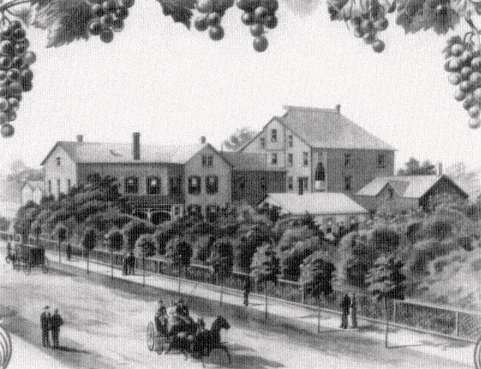
107
Michel Hommel's winery, founded in 1878 in Sandusky, Ohio, by then the center of the Ohio
wine trade. Hommel, a Frenchman from the great champagne town of Epernay, had a distinguished
background in American wine: he had worked for Longworth in Cincinnati and for Cook in St. Louis.
Like them, he specialized in sparkling wine and made a solid success with his White Star brand.
(Author's collection)
yards of states on either side of Ohio—Pennsylvania, New York, and Michigan—accounted for other losses; so, too, did the diseases that Lake Erie growers for a long time had fondly hoped would not trouble them.[26] For a number of years, it is true, they escaped the rot and mildew that destroyed the vineyards along the Ohio River, but that time of immunity was only a postponement, not a permanent state of affairs. A heavy infestation of black rot showed up on the Lake Erie islands as early as 1862,[27] and though the disease was never as destructive as it was in the southern part of the state, it was a serious problem thereafter. The statistics of production show some violent swings from year to year, according to whether the rot or mildew did or did not appear in force in any given season. One estimate put the number of vines lost to disease throughout Ohio in the decade 1870-80 at 10,000 acres, a net decrease of 3,000.[28]
The extent to which the German influence permeated winemaking along Lake Erie in Ohio is at once apparent from a mere recital of winery names: Steuk (1855), Engels & Krudwig (1863), Miller (1865), Carl Lenk (1867), Peter Lonz (1884),
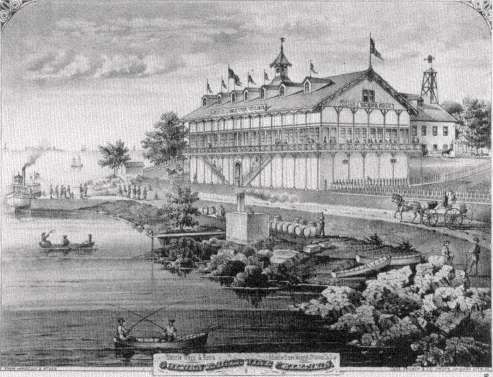
108
The Golden Eagle Winery on Middle Bass Island, Lake Erie, Ohio, at one time supposed to
have been the biggest in the United States. One of its proprietors, Michael Werk, had begun
winegrowing in Cincinnati in the era of Longworth and had migrated successfully to the Lake
Erie region to continue the work there after the industry around Cincinnati fell victim to disease.
The building, much altered, still stands. (Author's collection)
Gustav Heineman (1886). The giant among these firms was the Golden Eagle Winery, founded in 1861 on Middle Bass Island by Michael Werk and Andrew Wehrle; with a capacity of 500,000 gallons it was, for a time at least, regarded as the biggest winery in the United States.[29]
Kelley's Island, the largest of the Lake Erie islands on the American side, and the first of them to be planted to vines, was the site of a considerable winemaking activity. The largest establishment was the Kelley's Island Wine Company, housed in a ponderous stone building looking like a feudal castle, and capable of storing 350,000 gallons of wine. Its operations were interestingly described by the French botanist J.-E. Planchon, on a visit of inspection in the vintage season of 1873. Grapes were brought in by wagons from all over the island, weighed, paid for on the spot, and sent by a steam-driven conveyor to the top floor of the winery, where they were crushed, destemmed, and the juice separated from the skins. The juice then went to the fermentation vats on the second floor, while the skins descended
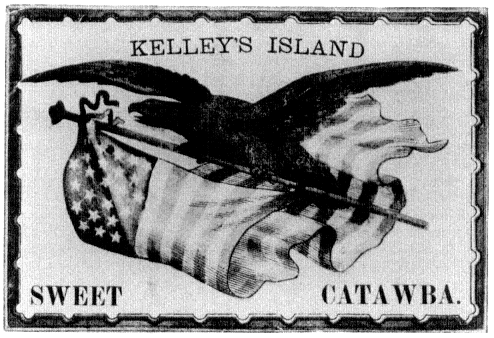
109
The first of the Lake Erie islands on the American side to be planted, Kelley's Island flourished
as a place of winemaking in the 1860s and 1870s. The Kelley's Island Wine Company crushed
9,000 tons of grapes in 1879, the produce of around 2,000 acres of vineyard. (From Bella
C. Landauer, Some Alcoholic Americana [1932])
to the ground floor, where six great steam-powered presses, each one capable of handling three tons of material in six hours, awaited them. Below ground were two levels of vaulted cellars for the storage of wine in both casks and bottles, including champagne storage. The wines were made and bottled as varietals, including Concord, Ives Seedling, Delaware, Isabella, and Iona. There were nine other substantial wineries on Kelley's Island at the time, ranging from 50,000 to 350,000 gallons of storage capacity. Planchon was particularly struck by the cellar of the German Thomas Rush, with its rows of well-made and scrupulously maintained casks and vats; they reminded him, Planchon wrote somewhat extravagantly, of "the work of that race of powerful drinkers, who, in times past, symbolized the cult of Bacchus along the banks of the Rhine in the great Heidelberg tun."[30]
Planchon's observations, in Ohio and elsewhere, on the practices of American winemaking, are worth summarizing. In the first place, he tells us, the practice of chaptalizing—that is, of adding sugar to a must deficient in natural sugar—was standard in seasons when the grapes did not ripen sufficiently. This, he thought, was a perfectly innocent proceeding, especially if the sugar came from cane rather than potatoes: the latter sort gave the wine a strange flavor. More dubious was the
equally widespread practice of making wine twice out of the same grapes: first the free-run juice was converted into white wine, and then the marc , the residue of skins and seeds, was fermented into a red wine by the addition of water and sugar. In this manner, Planchon noted, the Concord would give first a "white wine with a not very pronounced flavor, then an inferior red wine, agreeable enough and stable enough to keep." The practice of turning the residue of skins from the press into a thin, sharp wine called piquette was traditional in France, but the American product, according to Planchon, was better than that; the grapes had "superabundant quantities of acids, tannin and aroma" in their skins, and needed only sugar added to make a genuine wine.[31]
Planchon assured his French readers that despite the American winemakers' regular use of artificial methods, the average quality of American wine was higher than that of France—"superior not only to the frightful brews with which, under the name of wine, the public poisons itself in our cabarets, but superior to our petits vins de consommation courante. "[32] He reassuringly pointed out at the same time that the production costs of wine in eastern America were too high to raise a serious threat to the French, even though he was writing in the very depths of the phylloxera devastation in France. Far more likely, he thought, was the possibility that wines made from American vines grown in France would be exported to the United States.[33] It would be interesting to know whether such a thing ever did in fact happen, following the extensive planting of American vines as direct producers in France in the last quarter of the nineteenth century. Very possibly it did, though I have no evidence on the subject.
Michigan, like Ohio, Pennsylvania, and New York, a state where fruit growing was traditional thanks to the climatic influences of the Great Lakes, was a natural region for the extension of the viticulture already established along the Lake Erie shore. A vineyard was planted along the lake at Point de Peau, near Monroe, in 1863 by Joseph Sterling, and a few years later this region was proclaiming itself a new Rhineland.[34] As a matter of fact, the river in the region had been named the Raisin River by French voyageurs on account of the wild grapes growing there,[35] and the literal name "raisin" was doubtless closer to actuality than the poetic "Rhine," even though here, as so frequently elsewhere, the growers were largely German. By 1890 there were a half dozen wineries in and around Monroe, producing wine from the standard eastern native varieties.[36] The really considerable development in Michigan was in the "fruit belt" in the southwestern corner of the state, where the waters of Lake Michigan tempered the climate to suit the production of apples, cherries, and grapes. A sizeable beginning was made there shortly after the Civil War. By 1880 there were already more than 2,000 acres of vineyard.[37] Some of the traditional eastern wine varieties—Catawba, Delaware, and Dutchess—were grown and some wine produced, but Michigan was dominated by the Concord. In 1900, there were only five small wineries in the state, with a production of only 33,000 gallons, scattered in the region of Monroe (on the Lake Erie side) and Muskegon (on the Lake Michigan side).[38] The growth of Michigan as a wine-producing state did not really begin until after Prohibition.
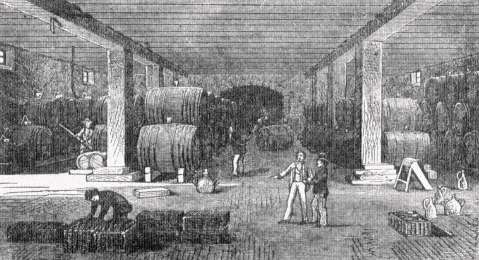
110
Vaults of the Egg Harbor Vineyards, Egg Harbor City, New Jersey, in the sandy flatlands
of the southeastern part of the state, a center of red wine production in the eastern United
States that was largely in the hands of German producers. (From Industries of New Jersey [1883])
Pennsylvania, to finish this brief review of winegrowing in the Great Lakes states, has its short stretch of Lake Erie shore in the far northwest of the state, in Erie County, linking the grape belts of New York and Ohio. Indeed, from Cleveland on the west to Buffalo on the east and north, the region is essentially one from the point of view of the grape, and the Pennsylvania section has shared the same development as the rest. Commercial winemaking began in Erie County as early as 1863, but after flourishing briefly was displaced by the spread of the Concord and the dominance of the table grape and juice markets. From a high of 97,000 gallons of wine in 1870, Pennsylvania—which largely meant Erie County—slipped to only 51,000 gallons in 1900.[39] Commercial winemaking on a modest scale also persisted in the German-settled parts of the state, where some success had been gained with the Alexander grape in the 1820s in York County. In the latter part of the century there were small wineries in and around Reading, all operated by Pennsylvania Dutchmen.[40]
In New Jersey the beginning made in the eighteenth century by Edward Antill and William Alexander had not been followed up in any effective way, though there are many sites in the state well suited to viticulture that might have encouraged continued experiment. The abundance and quality of New Jersey apples had suggested another sort of possibility to the farmers and orchardists. Jersey cider had been famous since early colonial times, and it was an easy step to make it sparkle and to offer the result to the public as "champagne." Newark was the center of this trade, well established by the 1840s. The Scottish traveller Alexander Mackay was told then that most "imported champagne" in America came in fact
from Newark. Even under its assumed name, Mackay found it "excellent as a summer drink. Many is the American connoisseur of champagne who has his taste cultivated on Newark cider."[41] The fountain of cider that flowed through New Jersey also supplied the stills that made applejack, or Jersey Lightning. Essex County, where Newark is, alone produced 300,000 gallons of applejack in 1810, and though a growing temperance movement much reduced production thereafter, there were still 388 distilleries in New Jersey in 1834, some of them no doubt kept in operation by the state's bountiful apple crop.[42]
Proper winegrowing began at the time of the grape boom of the 1850s and 1860s, in the region of Egg Harbor City in the sands of south Jersey. Here an agricultural society was organized in 1859 and carried out tests of some forty different grape varieties to determine which were best suited to the local conditions.[43] The dozen varieties selected included the staple Concord and Catawba, but also the briefly popular but now forgotten Martha, and, most interestingly, several native varieties for the production of red wine: Norton, Ives, Eumelan, and Clevener.[44] At Egg Harbor City, as in so many other places, the first impetus was from the Germans; the Gardener's Monthly reported in 1865 that the town, which had hardly existed eight years earlier, was now full of Germans making wine, "as good as any in the world" according to the boast of one of them.[45] Julius Hincke, Jacob Schuster & Son, August Heil, Charles Saalman, and J. Furrer were among these early producers:[46] they were soon joined by H. T. Dewey & Sons, whose vineyards were originally on the Lake Erie shore of Ohio, and by L. N. Renault, who bought land in Egg Harbor City in 1864.[47] In the early days Hincke was the enterprising grower of the region. He exhibited his wines to good effect at the great Philadelphia Centennial Exhibition in 1876 and at the Paris Exposition of 1878, winning medals at both for wines that he called "Iohlink" and "Franklin"—the latter is the name of a native variety, but what was "Iohlink"?[48] The firm of Dewey was long known for its red wine from the Norton grape, and Renault for its New Jersey champagne—this one from grapes rather than apples. Production was considerable, but never large enough to make much of a difference to the market: by 1879 there were nearly 800 acres of vineyard around Egg Harbor City; in 1900, a year of peak production, New Jersey made about 220,000 gallons of wine from eleven wineries. Native red wines, never very common in the east, gave New Jersey its special place in American winegrowing.
Only a few miles away from Egg Harbor City, at Vineland, New Jersey, something was going on that would make a profound difference to the character of grape growing in the east. This was the invention of grape juice. Vineland was a real estate speculation promoted, successfully, by a Philadelphia lawyer named Charles Landis, beginning in 1861, on 32,000 acres of cutover and swampy land in southern New Jersey. "Intending to make it a vine country," Landis said of one of the towns he laid out on his acres, "I called it Vineland."[49] He did not, however, explain why it should also have a charter forbidding the sale of alcoholic beverages, but so it did. The combination of viticulture and prohibition, which strikes
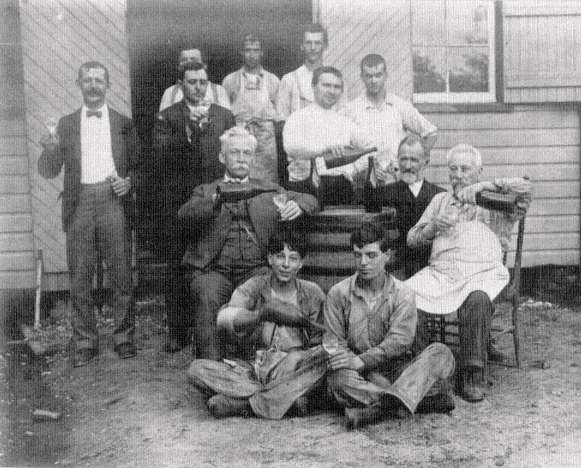
111
Workers (and a proprietor?) at the Renault Winery in Egg Harbor City, New Jersey, enjoying
the sparkling wine for which the firm was noted. The picture was taken in 1906. (Huntington Library)
us as so strange, is pretty clear evidence of the strength of prohibitionist sentiment and of the establishment of a table grape market as an alternative to winemaking so early as 1861: we have already noticed a comparable development in Chautauqua County, New York, just after the Civil War. Landis's temperance principles did not, however, prevent a large Italian community settled at Vineland in the 1870s from making wine in commercial quantities; a German named Peter Lenk also operated a winery in Vineland until black rot destroyed the supply of grapes at the end of the eighties.[50]
To Vineland there came in 1868 a dentist named Thomas Welch, a restless type of which the American nineteenth century seems to have had so many. English-born, but reared in upstate New York, he had been a Wesleyan preacher, then a
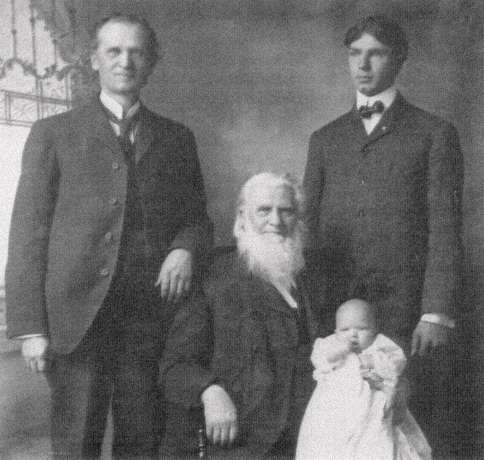
112
Four generations of the Welch family. Dr. Thomas Welch, the inventor of grape juice, is
seated; his son, Dr. Charles E. Welch, the successful promoter of the invention, stands
on the left. The picture dates from some time before 1903, when the elder Welch died.
(From William Chazanof, Welch's Grape Juice [1977])
doctor, and then a dentist, practicing in New York State and in Minnesota before fetching up in Vineland. He liked to experiment and to diversify: he had invented a stomach-soothing syrup, had made a trade in compounding and selling dental alloys, and had devised a "Sistem of Simplified Spelling."[51]
In Vineland, where he was communion steward to the Vineland Methodist Church, he began to take thought about the problem of wine in the sacrament. To Dr. Welch, and to many other ardent prohibitionists, the centrality of wine in the service of the Christian church was a rock of offense and a stone of stumbling. To the riddle of how Our Lord could possibly have recommended the Demon Rum—anything alcoholic was so identified in the circles to which Dr. Welch be-longed—as the symbol of His own sacrificial presence there seemed to be only one
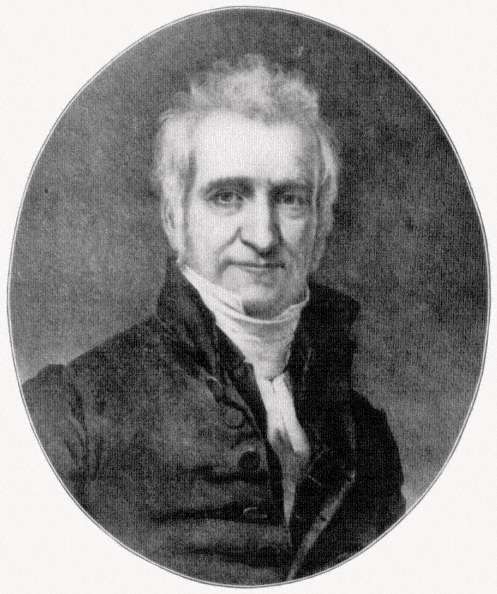
113
Eliphalet Nott (1773—1866), Presbyterian minister, prohibitionist, and for sixty-two
years president of Union College, Schenectady, New York. He revived the notion
that there were two kinds of wine mentioned in the Bible, one fermented, the other
not, and so helped to contribute to the invention of grape juice. (From Andrew Van
Vranken Raymond, Union University [1907])
answer: the wine of these latter days was a sad corruption of the wine Our Savior knew, which must have been an innocuous temperance beverage suitable to divine purity. By what distortions and evasions of historical and philological evidence such people were able to sustain their conviction we need not trouble to discuss here.[52] The case is a clear instance, if one is needed, of the power of the wish over the fact.
But Dr. Welch, in Vineland, in 1869, had an unprecedented opportunity to realize that wish—in fact, to make a non-alcoholic "wine." For two things had come together for him: first, he had the vineyards of Vineland all around him, and second and most important, he had learned of the experiments of Pasteur in the control of fermentation. The process we call pasteurization had been made known only a few years before, but its obvious importance had spread it abroad quickly—it was discussed in the Transactions of the California State Agricultural Society in 1867, for example. Now, thinking about how he, an incorruptible prohibitionist, could supply wine for the communion services of his church, Dr. Welch was inspired to try the effect of heating an unfermented grape juice. I know of no positive evidence on the question, but the juice he used was presumably that of the Concord grape. By the simple expedient of bringing a liquid to a temperature of 140° Fahrenheit, as Pasteur had shown, one could kill whatever yeasts it contained and so preserve it against fermentation. Thus was the first preserved grape juice of which we have record created. It was certainly a new thing under the sun. The three great staples of classical Western civilization—bread, cheese, and wine—are all the products of a natural process of fermentation that both transforms and preserves the substances upon which it works. Now, in the name of the "natural," but in fact through the application of modern technological understanding, an American dentist had shown how to hold the blood of the grape in artificial arrest. It was the final insult to injured nature to call it, as its inventor did, "Dr. Welch's Unfermented Wine," and to sell it in burgundy-style bottles—a parody in name, appearance, and substance.[53]
Welch made some efforts to sell his product, but gave up after a few years, having met with little encouragement. In 1875, however, his son, Charles E. Welch, also in practice as a dentist, determined to resume the manufacture and sale of his father's invention. He evidently saw its commercial possibilities, but for many years after the younger Welch took it over, the business remained shaky. At last, in 1893, Charles Welch quit his dental practice and devoted himself wholly to the business of "grape juice," as he had now decided to call it (in England, though, it was sold as "Unfermented Port wine").[54] Shortly thereafter, the vineyards in New Jersey were smitten by black rot and the supply of grapes became a critical problem. Charles Welch at once moved his operations to upstate New York, first to Watkins Glen on Seneca Lake, and then, after only a year, to Westfield, in the grape belt of Chautauqua County. That was in 1897. In that year, Welch's Grape Juice Company pressed about 300 tons of Chautauqua County Concords and sold 50,000 gallons of the pasteurized juice; a decade later, sales had reached a million gallons annually.[55]
The success of grape juice in the American market clearly owed much to preexisting prohibitionist sentiment, as its invention had; but Charles Welch understood the importance of advertising, and he effectively combined moral uplift with commercial astuteness. He founded two magazines to promote his product, one called The Acorn in 1875, and five years later another called The Progress :[56] in these Welch could put his advertisements of grape juice together with editorial matter promoting the temperance cause and the virtues of Welch's grape juice, the whole flavored with fundamentalist Christianity and the offer of premiums. "If your druggist hasn't the kind that was used in Galilee containing not one particle of alcohol, write us for prices," as one ad put it.[57] And, since temperance and religion might not be attraction enough, grape juice was described as good for everything that might ail one: "Dr. Welch's Grape Juice is especially recommended in Typhoid Fever, Pneumonia, Pluritis [sic ], Peritonitis, Rheumatis, for Lying-in Patients and for all forms of chronic diseases except Diabetes Melitus."[58] Since Charles Welch certainly did especially recommend his grape juice to all and sundry, there was that much truth in this claim, and, perhaps, not too much harm. One may note that for many years grape juice was a drugstore, rather than food store, item, which no doubt affected the character of its advertising.[59]
Welch did not confine his promotional efforts to print. He took advantage of the Columbian Exposition of 1893 to set up a stand and distribute samples of grape juice to the crowds gathered in Chicago, as he did later at the St. Louis World's Fair and at other expositions. He also set up a permanent stand on the boardwalk at Atlantic City to catch the holidaymakers in their thousands. In his program of national advertising, he made grape juice all things to all people: for the medical trade it was presented as a tonic; for the religious, as a scriptural necessity; for the secular, as a pleasant drink. Later, in the vacuum created by Prohibition, the company was even bold enough to proclaim Welch's grape juice "the national drink."[60]
The demands of the Welch Company for Concord grapes ensured that the Lake Erie grape belt would remain entirely dominated by that variety, and not only the Lake Erie grape belt. It was not long before new regions were devoted to the growing of Concords and the supply of Welch's grape juice. Welch had bought out a large competitor at North East, Pennsylvania, only a few miles away from West-field, in 1911. As expansion continued, the company built a new plant at St. Catharine's, Ontario, in 1914, amidst the vineyards of the Niagara Peninsula; in 1918 the company acquired a plant at Lawton, Michigan, in the grape-growing southwest corner of the state.[61] Prohibition being a boon to the grape juice industry rather than the bane it was for the winegrower, Welch's added another factory in 1922, this one at Springdale, Arkansas, in the Ozarks, where 15,000 acres of company vineyards were planted, or so a company statement proclaimed in 1925.[62] Official figures are much more modest, though substantial.[63] By the end of this process of expansion grape growing outside of California was virtually synonymous with growing Concords for the provision of juice, jams, and jellies. That situation is now, at last, beginning to change, but only beginning. For most of its modern
history, and apart from merely natural conditions, eastern viticulture has been shaped by three historic events in combination: the introduction of the Concord grape in 1854; Dr. Welch's invention of grape juice in 1869; and the institution of national Prohibition in 1920. Together they have powerfully retarded the growth of a healthy wine industry.